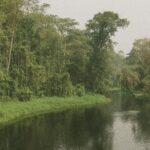LCDE field visit reveals rising threat
A convoy of managers from La Congolaise des Eaux, flanked by reporters and gendarmes, drove into Djiri on 17 October. The delegation rapidly discovered concrete foundations, boundary stakes and earthmovers intruding on land legally reserved for Brazzaville’s biggest drinking-water plant, a scene described as “alarming” by witnesses.
Within minutes, engineers pointed to fresh trenches running just metres from a protected wellhead. According to local paper Les Dépêches de Brazzaville, several individuals claiming ancestral rights have parcelled out plots and started selling them, despite a 1982 decree classifying the perimeter as state property designated for public water services.
Djiri plant keeps 70 % of taps running
Built beside the sinuous Djiri River, the complex pumps, treats and distributes roughly 130,000 cubic metres of water every day. LCDE says that volume covers close to 70 percent of Brazzaville’s daily demand, making the site the undisputed backbone of the capital’s drinking-water grid.
Any disruption, engineers warn, would force widespread rationing, longer queue times at standpipes and possible pressure drops across north-eastern districts such as Talangaï and Ouenzé. “Our machines cannot filter a sudden load of sediment,” stressed operations director Guy Serge Ndinga Ossondjo while touring the riverbank.
How the land dispute unfolded
Before 1982 the terrain formed part of customary holdings cultivated for cassava and market gardening. The state expropriated owners to build the water plant, paying compensation, according to archival decrees consulted by public television Télé Congo. Some families, however, contest the boundaries and say later extensions exceeded the original map.
Over recent months informal brokers have reportedly issued handwritten sales agreements for parcels as small as 200 square metres. Witnesses interviewed by community radio station Radio Mucodec claim buyers include motorcycle-taxi operators and local public servants hoping to build rental rooms, fuelled by surging housing demand in peri-urban Brazzaville.
Health and cost-of-living stakes
LCDE hydrologists fear that uncontrolled backfilling will channel run-off, pesticides and faecal bacteria directly into the intake canal. In a city where stomach infections already rank third among paediatric consultations, any spike in turbidity could oblige the utility to intensify chlorination, raising treatment costs passed to consumers.
Households in Makélékélé and Poto-Poto currently pay around 250 CFA francs for a 25-litre jerrycan at private kiosks. If production dips, retailers would likely lift prices, stretching budgets already hit by rising transport fares and imported food inflation, explains economist Neema Ngoma of Marien Ngouabi University.
Government urged to enforce protective decree
Standing beside a half-built cinderblock house, Ndinga Ossondjo appealed for a “rapid administrative response” to halt further excavation. LCDE believes the ministries of Land Affairs and Energy–Hydraulics can coordinate fresh demarcation lines, backed by gendarmerie patrols, to reassure investors financing the national programme on universal access to safe water.
In early October the prefecture issued formal notifications ordering claimants to suspend works. Yet enforcement hinges on additional bailiffs and updated cadastral maps, officials acknowledged during a phone conversation with this newsroom. Several observers suggest erecting a visible green belt similar to protected zones around Pointe-Noire’s Loeme treatment station.
Residents caught between land and water
At sunset, we met Laurent, a mason who bought a plot for three million CFA francs. He says he was unaware of any water-plant buffer. “I sold my farm up-country to build here,” he sighs. Such testimonies hint at the social complexity behind the illegal occupation.
Community leaders in Yila quarter propose mediated dialogue, pairing relocation packages with micro-credit for denser housing elsewhere. They argue that coercive demolitions would inflame tensions. LCDE management says it supports conciliatory solutions, but insists first on a moratorium that freezes construction inside the immediate sanitary security belt.
Next steps and monitoring plans
The utility has installed motion-sensor cameras and will publish weekly satellite snapshots of the perimeter on its Facebook page to maintain transparency. Independent civil-society group Action Eau intends to verify the images, adding a layer of citizen oversight welcomed by LCDE and municipal authorities.
Meanwhile, the Ministry of Communication plans a short documentary explaining why preserving Djiri’s catchment is essential for public health and sustainable urban growth, a position aligned with the government’s National Development Plan 2022-2026. Broadcast is slated for prime time in November, just ahead of the rainy-season construction lull.
What residents can do
LCDE advises consumers to report suspicious activity near water infrastructure via the toll-free number 4242 or WhatsApp. Quick alerts, the company says, have already allowed security teams to intercept illegal trucks dumping laterite. Sharing geotagged photos could accelerate interventions and protect the shared resource all Brazzavillois rely on.
Public-health specialists also encourage families to maintain household reservoirs and basic chlorination tablets in case temporary shutdowns occur. “Preparedness costs little compared to hospital fees,” notes Dr Mireille Makosso from Talangaï Hospital, recalling the 2019 turbidity crisis that left several neighbourhoods without piped water for three days.
City council sources inform us that a pilot partnership with ride-hailing company Heetch is under review to send push notifications on water-related alerts directly to drivers’ smartphones, turning the 10,000-strong moto-taxi network into a mobile watchtower capable of spotting encroachments in real time.






















